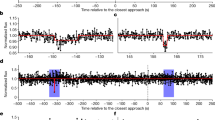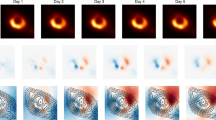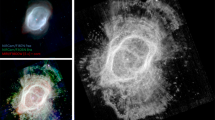Abstract
Saturn’s narrow F ring exhibits several unusual features that vary on timescales of hours to years. These include transient clumps, a central core surrounded by a multistranded structure and a regular series of longitudinal channels associated with Prometheus, one of the ring’s two ‘shepherding’ satellites. Several smaller moonlets and clumps have been detected in the ring’s immediate vicinity, and a population of embedded objects has been inferred. Here we report direct evidence of moonlets embedded in the ring’s bright core, and show that most of the F ring’s morphology results from the continual gravitational and collisional effects of small satellites, often combined with the perturbing effect of Prometheus. The F-ring region is perhaps the only location in the Solar System where large-scale collisional processes are occurring on an almost daily basis.
This is a preview of subscription content, access via your institution
Access options
Subscribe to this journal
Receive 51 print issues and online access
$199.00 per year
only $3.90 per issue
Buy this article
- Purchase on Springer Link
- Instant access to full article PDF
Prices may be subject to local taxes which are calculated during checkout




Similar content being viewed by others
References
Gehrels, T. et al. Imaging photopolarimeter on Pioneer Saturn. Science 207, 434–439 (1980)
Smith, B. A. et al. Encounter with Saturn: Voyager 1 imaging science results. Science 212, 163–191 (1981)
Smith, B. A. et al. A new look at the Saturn system: The Voyager 2 images. Science 215, 504–537 (1982)
Tyler, G. L., Marouf, E. A., Simpson, R. A., Zebker, H. A. & Eshelman, V. R. The microwave opacity of Saturn’s rings at wavelengths of 3.6 and 13cm from Voyager 1 radio occultations. Icarus 54, 160–188 (1983)
Marouf, E. A., Tyler, G. L. & Rosen, P. M. Profiling Saturn’s rings by radio occultation. Icarus 68, 120–166 (1986)
Lane, A. L. et al. Photopolarimetry from Voyager 2: Preliminary results on Saturn, Titan and the rings. Science 215, 537–543 (1982)
Bosh, A. S., Olkin, C. B., French, R. G. & Nicholson, P. D. Saturn’s F ring: Kinematics and particle sizes from stellar occultation studies. Icarus 157, 57–75 (2002)
Porco, C. C. et al. Cassini imaging science: Initial results on Saturn’s rings and small satellites. Science 307, 1226–1236 (2005)
Giuliatti Winter, S. M., Murray, C. D. & Gordon, M. Perturbations to Saturn’s F ring strands at their closest approach to Prometheus. Planet. Space Sci. 48, 817–827 (2000)
Murray, C. D. et al. How Prometheus creates structure in Saturn’s F ring. Nature 437, 1326–1329 (2005)
Charnoz, S. et al. Cassini discovers a kinematic spiral ring around Saturn. Science 310, 1300–1304 (2005)
Porco, C. C. Satellites and rings of Saturn. IAU Circ. 8432, (2004)
Showalter, M. R. Detection of centimeter-sized meteoroid impact events in Saturn’s F ring. Science 282, 1099–1102 (1998)
Showalter, M. R. Disentangling Saturn’s F ring. I. Clump orbits and lifetimes. Icarus 171, 356–371 (2004)
Esposito, L. W., Meinke, B. K., Colwell, J. E., Nicholson, P. D. & Hedman, M. M. Moonlets and clumps in Saturn’s F ring. Icarus 194, 278–289 (2008)
Cuzzi, J. N. & Burns, J. A. Charged particle depletion surrounding Saturn’s F ring: Evidence for a moonlet belt? Icarus 74, 284–324 (1988)
Barbara, J. M. & Esposito, L. W. Moonlet collisions and the effects of tidally modified accretion in Saturn’s F ring. Icarus 160, 161–171 (2002)
Poulet, F., Sicardy, B., Nicholson, P. D., Karkoschka, E. & Caldwell, J. Saturn’s ring-plane crossing of August and November 1995: A model for the new F ring objects. Icarus 144, 135–148 (2000)
Porco, C. C. et al. Cassini imaging science: Instrument characteristics and anticipated scientific investigations at Saturn. Space Sci. Rev. 115, 363–497 (2004)
Murray, C. D. & Dermott, S. F. Solar System Dynamics Ch. 7 (Cambridge University Press, Cambridge, UK, 1999)
Dermott, S. F. & Murray, C. D. Origin of the eccentricity gradient and the apse alignment of the epsilon ring of Uranus. Icarus 43, 338–349 (1980)
Murray, C. D. et al. Saturn’s F ring and its retinue. Bull. Am. Astron. Soc. 37 3 (Annual DPS meeting), abstr. 64.05 (2005)
Spitale, J. N., Jacobson, R. A., Porco, C. C. & Owen, W. M. The orbits of Saturn’s small satellites derived from combined historic and Cassini imaging observations. Astron. J. 132, 692–710 (2006)
Tiscareno, M. S. et al. 100-metre-diameter moonlets in Saturn’s A ring from observations of ‘propeller’ structures. Nature 440, 648–650 (2006)
Borderies, N. & Goldreich, P. The variations in eccentricity and apse precession rate of a narrow ring perturbed by a close satellite. Icarus 53, 84–89 (1983)
Showalter, M. R., Pollack, J. B., Ockert, M. E., Doyle, L. R. & Dalton, J. B. A photometric study of Saturn’s F ring. Icarus 100, 394–411 (1992)
Acknowledgements
C.D.M., K.B., N.J.C., M.W.E. and G.A.W. are grateful to the UK Science and Technology Facilities Council for financial support. The success of the FMOVIE observations described in this paper is due to the invaluable assistance of M. Showalter and the Cassini VIMS team. The authors also wish to thank R. Nelson, D. McNeil, J. Burns and our other colleagues on the Cassini project for numerous discussions.
Author Contributions C.D.M. led the research, worked on image analysis and carried out the jet simulations. K.B. and M.W.E. wrote database and image analysis software, and contributed to image sequence design. Satellite and ring orbit analysis was done by N.J.C., as were the simulations of S/2004 S 6 encountering the F ring. Simulations of planar ring–satellite interactions were done by G.A.W. C.D.M., K.B., N.J.C., M.W.E., G.A.W. and S.C. all contributed to the theories discussed.
Author information
Authors and Affiliations
Corresponding author
Supplementary information
Supplementary information
The file contains Supplementary Figures 1-10 with Legends; Supplementary Tables 1-2 with Legends and Supplementary Video Legends 1-4. (PDF 1554 kb)
Supplementary information
The file contains Supplementary Video 1 showing animation of a massive S/2004 S 6 crossing a massless F ring core. (MOV 4487 kb)
Supplementary information
The file contains Supplementary Video 2 showing animation of a massive S/2004 S 6 crossing a massless F ring core viewed from two different angles. (MOV 2951 kb)
Supplementary information
The file contains Supplementary Video 3 showing a numerical simulation of the effect of a ~5 km-radius satellite on a circular, 50 km-wide ring of test particles followed over one orbital period and viewed in a rotating reference frame. (MOV 601 kb)
Supplementary information
The file contains Supplementary Video 4 showing a numerical simulation of the effect of a conjunction between Prometheus and a ~5 km-radius satellite on a circular, 50 km-wide ring of test particles followed over one orbital period and viewed in a rotating reference frame. (MOV 2812 kb)
Rights and permissions
About this article
Cite this article
Murray, C., Beurle, K., Cooper, N. et al. The determination of the structure of Saturn’s F ring by nearby moonlets. Nature 453, 739–744 (2008). https://doi.org/10.1038/nature06999
Received:
Accepted:
Issue Date:
DOI: https://doi.org/10.1038/nature06999
This article is cited by
-
Prometheus Induced Vorticity in Saturn’s F Ring
Earth, Moon, and Planets (2016)
-
Saturn’s F ring and shepherd satellites a natural outcome of satellite system formation
Nature Geoscience (2015)
-
Gravitational Vortices And Clump Formation In Saturn's F ring During An Encounter With Prometheus
Scientific Reports (2013)
Comments
By submitting a comment you agree to abide by our Terms and Community Guidelines. If you find something abusive or that does not comply with our terms or guidelines please flag it as inappropriate.



